This is a KW Prakti, a fully automatic 35mm camera produced by VEB Kamera und Kinowerke Dresden from 1961 to 1964. The Prakti is notable as being one of the first cameras to not only have an internal electric motor for advancing the film and cocking the shutter, but also that it is powered by two AA “pen light” batteries, something that few cameras had adopted in the early 1960s. It is a fully automatic camera that controls both auto exposure via it’s large selenium exposure meter and focus based on six icons on the camera’s top plate. Independent control over focus, shutter speeds, or aperture is not possible, you simply choose which of the six settings applies to the shooting situation you are in, and the camera does the rest.
Film Type: 135 (35mm)
Lens: 40mm f/4 Meyer-Optik Görlitz Domiton coated 4-elements in 3-groups
Focus: 1 meter to Infinity with Scene Based Zones
Viewfinder: Scale Focus with w/ viewfinder match needle
Shutter: Prestor-00 Behind the Lens Leaf
Speeds: B, 1/30 – 1/250 seconds (unmarked, based on four zones)
Exposure Meter: Coupled Selenium Cell w/ Shutter Priority Auto Exposure
Battery: (2x) 1.5v AA Battery
Flash Mount: PC Flash Sync
Weight: 679 grams
Manual (in German): https://www.cameramanuals.org/praktica_pdf/prakti.pdf
How these ratings work |
The KW Prakti is a strange looking and functioning camera that was not typical of other East German cameras of the time. Featuring a fully automatic film transport and exposure system that also controlled focus, the Prakti was the ultimate early 1960s point and shoot. Unfortunately, it’s electronics were unreliable when the camera was new and it’s only gotten worse from there, making finding a working Prakti extremely difficult. If you can find one that works, they are capable of excellent images as the 4-element Domiton lens was as good as anything at the time, but for most people, these are more likely to be used as display pieces. | ||||||
| Images | Handling | Features | Viewfinder | Feel & Beauty | History | Age | |
| 2 | 1 | 1 | 2 | 2 | 1 | 20% | |
| Bonus | +1 for tons of innovation, a truly unique camera | ||||||
| Final Score | 11.8 | ||||||
Respect: I started working on this article earlier this spring and had about 90% of it written when another review of the Prakti by Marco Kröger was posted. Although entirely in German, Marco’s review absolutely slays anything I have below. The amount of detail in both text and in images he included in his review is absolutely amazing. His article is worth the read even if you have to rely on Google Translate for a rudimentary English translation. He’s got a lot of terrific historical images of the camera showing it being assembled, one taken apart, schematics, and other excellent ephemera. If every review for an old camera was as thorough and detailed as Marco’s, I wouldn’t need to have this site.
https://zeissikonveb.de/start/kameras/prakti.html
Despite not having anywhere near the info of Marco’s review, I finished mine as I can say it’s the most thorough Prakti review written in English, but if you really want to learn about the camera’s history, you definitely need to check out Marco’s article.
History
In the second half of the 20th century, both the Soviet and East German camera industries weren’t exactly known as pioneers of innovative and interesting designs. A huge number of Kiev, Zorki, FED, Praktica, and Exakta cameras were still being produced based heavily on decades old pre-war designs. In the case of the Kiev rangefinder, the camera was a continuation of the 1930s Contax II and III and remained in production with only minimal updates, until 1987. While the original KW Praktiflex and Prakticas were quality made SLRs, VEB Pentacon continued the same basic formula with only small changes until the 1990s.
But to say that neither Soviet or East German companies ever made anything interesting isn’t true either. The KMZ Start, GOMZ Voskhod, and Pentacon Pentina are three examples of new designs that shared little in common with other established brands.

Another camera that belongs in the latter category of interesting designs, is the KW Prakti as the only thing that’s not interesting about it, is it’s name. Despite sounding like a scaled down Praktiflex or Praktica, the Prakti shared nothing in common with any other East German camera.
One of the signature features of the Prakti was it’s use of an electronic motor for film transport which was powered by AA “pen light” batteries. The Prakti was the second 35mm camera to have this feature, losing out on being the first by the Iloca Electric (branded in the US as the Graflex Graphic 35 Electric) in 1959.
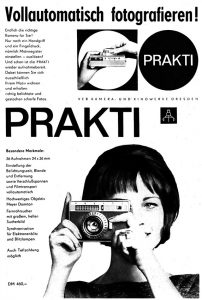
In addition to the electrically motorized transport, the Prakti was one of the most automatic cameras of it’s era. Featuring not only a scene based automatic exposure system, the camera also sets focus based on which scene is used. The depth of field afforded by the 40mm Domiton lens means that the camera doesn’t have to work too hard to produce in focus results in any of the camera’s modes.
The existence of the Prakti is a bit unusual, as by the 1960s the East German camera industry was made up of mostly nationalized companies who produced cameras in one of two categories. The first category consisted of single lens reflex models like the Exakta and Praktica which were largely built for export. The GDR’s economy was still weak at the time, and having a product that could inject money from western countries was seen as vital to the country. The second type were extremely basic point and shoot models made by Certo and Belca which lacked automation or any kinds of advanced features as they were sold cheaply for the domestic market.
When work began on the Prakti, a camera with a motorized film transport, automatic exposure, and a coupled focusing system would have been quite ambitious for any company, let alone one from East Germany. The camera was designed by a variety of different people who all contributed in various ways to different parts of it. According to US and German patent information, work started with the film transport first, around 1960.
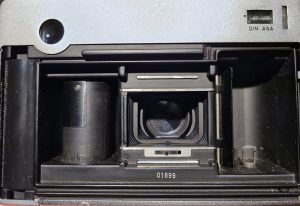
US Patent number US3135182 by Klaus Hintze and Günter Hausmann details some of the design of what would become the Prakti’s electric motor drive. As was the case of all cameras with a built in motor drive (both electric and clockwork) one of the biggest challenges was in finding room somewhere in the camera for the parts needed to make it work. Hintze’s design used the area of the take up spool to house the motor, but unlike similar designs by other companies, the take up spool was the outer shell of the motor. Whenever the motor would spin, it’s output shaft would remain fixed and the entire body of the motor would spin. This ensured that as little of space as possible would be needed to fit everything in.
Fitting the motor into the camera was just one of many challenges that would need to be overcome, however. Like a manual wind camera, a geared shaft that counted 8 perforations on the 35mm film was used to tell the motor when enough film had been advanced for the next exposure, but a challenge arose when detecting the end of the roll of film as you didn’t want the motor to keep trying to spin at the end of the roll. At best, you’d tear the end of the roll out of the cassette, but with stronger film, the chance of the motor becoming overstressed and burning out was something Hintze and Hausmann wanted to avoid.
The solution was to use the exposure counter and add a contact that would open when the counter reached 0. This meant that the Prakti would have a subtractive exposure counter, starting at how many exposures remained on the roll, rather than how many were used. When the counter would reach zero, the circuit would open, disabling the motor. This of course, assumes the photographer remembers to not only reset the counter, but also set the correct number of exposures, but at least it was a start.
One last challenge which was foreseen was that owners of the camera would likely experience dead batteries at some time while out shooting. AA “Penlight” batteries of the era were zinc-carbon dry cells which compared to modern day alkaline batteries, had a significantly shorter life. In addition, battery power would also be negatively affected when used in colder climates increasing the chances of a low voltage situation.

According to Marco Kröger’s research on the Prakti, some patent documentation suggested that a manual winding system was being developed, but never made it into the finished product. A combination of cost and the logistics of how you could create a camera with both an electrical and manual film advance system likely doomed the idea.
A great deal of effort was put into the metering system as well. In charge of it’s development was Werner Hahn and Johannes Weise who at times had considered multiple types of metering systems. Versions were considered with more advanced features and also the ability to manually control the aperture and shutter timings, but a simpler programmed design eventually won out, likely to keep costs down.
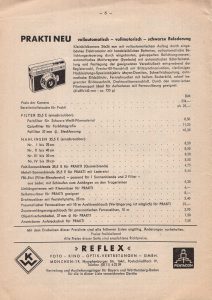
Wolfgang Hecking was responsible for what would become the Domiton lens for the Prakti. An all new 4-element in 3-group design, the Domiton was a Tessar-type lens whose 40mm focal length was unusual for the time. Hecking’s choice of a semi-wide angle standard lens occurred at almost the exact same time Heinz Waaske was working on a compact viewfinder camera while working for Wirgin. Waaske chose 40mm as it would not only allow for a much more compact lens, but also that it would offer greater depth of field simplifying focus for what would eventually become his Rollei 35 in 1966. It is unclear if Hecking or Waaske had any knowledge of each other’s work, but the resulting products whose demands and results were almost a perfect match is uncanny.
Several other men were involved in the design and construction of the shutter, viewfinder, body, and even the ever ready leather case, but rather than keep paraphrasing Marco Kröger’s research, I definitely recommend you check it out for yourself as his research goes over each area quite well.

It is not known exactly when the Prakti went into production. Many sources online say 1960, which is not likely as many of the patents that would eventually become the camera were still being filed then. We know that the camera was in production in February 1962, so an estimation of late 1961 seems like a good guess as to when the first cameras were finished.
Circling back to a comment I made earlier that the Prakti was unusual for an East German camera is reinforced by all of the technology and effort that went into it’s design. Nowhere in the Prakti will you find off the shelf parts. This was not a camera that was based off, or used ideas from pre-war cameras like so many other East German cameras. Even the mighty Exaktas and Prakticas of the day use designs and technology first developed before the war.
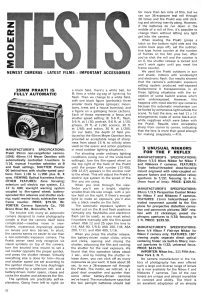
It is difficult to assess how popular the Prakti was, but it was produced for at least 3 years and according to the short Modern Tests review to the right from January 1963, the camera was exported to the United States by Camera Specialty Corp, in Bronxville, New York at a cost of $79.50. This price when adjusted for inflation compares to just under $700 today, making it an affordable option for what was then one of the world’s most fully automated cameras.
It is worth noting that Camera Specialty Corp was also known as Caspeco and was run by Max Wirgin, one of four Wirgin brothers, who with his brothers Heinrich and Josef Wirgin, founded Wirgin in Wiesbaden, Germany. After the war, Max stayed behind in America to open Caspeco who largely imported cameras from Wirgin and other lesser known German companies.
In 1963, a model called the Prakti II was released with a larger opening and trim piece for the front viewfinder (although the actual window is the same), different cosmetics of the mode selector ring, and a change to the film speed wheel on the back of the camera which now showed aperture f/stops. It was originally thought when the Prakti was developed that f/stops would confuse the user, so they were omitted, but these numbers later proved to be useful with flash photography.
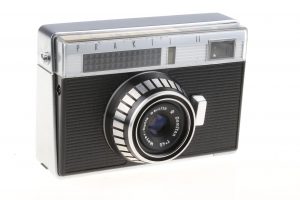
In the image to the left, we see a Prakti II with a black body covering, which differed from the grayish covering on earlier cameras. Other variations of the camera exist with black trim between the exposure meter and viewfinder windows. Black versions of the original Prakti exist as well, so I do not believe this to be another change with the Prakti II. Perhaps black versus gray bodied cameras were intended for different export markets, but that is just a guess.
The Prakti would eventually be discontinued in 1964, which was right around the time VEB Kamera und Kinowerke Dresden became VEB Pentacon Dresden. Less than 60,000 units were produced making the Prakti difficult, but not impossible to find today. Despite all of the effort put into the design of the various parts of the camera, it suffered quality control problems, there were problems with distribution in western countries, and compared to other East German cameras, at a domestic price of over 500 Mark (later lowered to 390 Mark and again to 234 Mark) it was not affordable to many.
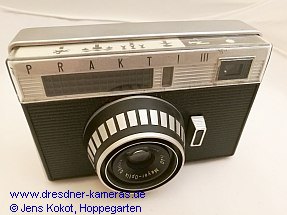
A Prakti III was developed with at least one prototype created, but it is not clear what changes (if any) were in what might have become the third model. Perhaps this model could have included some of the scrapped ideas in the original Prakti’s development such as the manual override film advance, or perhaps a more advanced metering system, but in the image to the right, nothing appears to be different other than the name and the look of the shutter release.
VEB Pentacon would continue to make Praktica cameras for the next several decades, but as the years would go on, what little remained of the prewar innovation often associated with Dresden area camera makers had completely disappeared.
Today, models like the Prakti are notable for their innovation, but aren’t highly sought after by collectors, at least not in the United States. Despite some evidence this camera was exported to the US, I’ve never seen one for sale in this country. I found no mention of the camera in any back of magazine ads in Modern or Popular Photography. For those who specifically collection East German cameras, this should be a definite add to your collection, but for everyone else, good luck at finding one, especially if you intend to use it.
My Thoughts
Around the time I reviewed the Pentacon Pentina M, I had found some information on the Prakti, and seeing it’s early implementation of a battery powered motor drive, I sought out to find one to review.
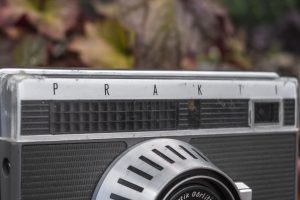
As is the case with many electronic cameras, these cameras have a significantly higher rate of failure than mechanical ones, and finding a working Prakti was extremely difficult. Making matters even more challenging is that these cameras are almost never found in the United States. Of the few that I did find, they were almost always in Europe and none ever mentioned anything about working. They were either confirmed non-working or listed as not tested which usually means “not working”. I finally took a chance on one that was for sale in the US and figured that even if it didn’t work, it would make for an interesting Camera of the Dead.
Before the camera arrived, I was well prepared for a heavy and ergonomic disaster. For some reason, the 1960s brought a resurgence in brick-like cameras. The Argus C3, originally designed in the 1930s was still in production and other companies like Mamiya were making “modern bricks” like the Sears branded Tower 41.
As expected, the Prakti has sharp edges and is rather heavy. The top of the front is covered by a large piece of plastic which on mine was cracked on both sides. Looking online at other Praktis, this seems to be a very common problem as most seem to have taken a hit or two over the years.
With two AA batteries and a roll of film, the camera is heavier than a C3, and with the shutter release requiring the photographer’s left index finger to use, the ergonomics definitely take some getting used to. On the plus side, the almost completely automatic operation of the camera eliminates the potential for other strange controls, so once you get used to the position of the shutter release, it’s really not that bad.
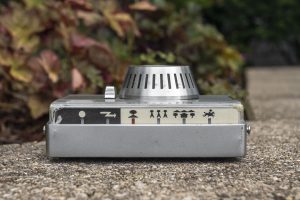
The camera’s top plate is the most interesting part of the camera as it has the unique icon based exposure and focus system. By turning the metal ring around the lens and shutter, a red marker moves between each of the six icons which not only determine exposure, but also the focus distance of the camera. They are:
- White circle, black background – Shutter is in Bulb mode and stays open as long as the shutter release is held down, focus is set to 2 meters offering variable depth of field depending on which f/stop is chosen, auto exposure is disabled. Diaphragm f/stops are chosen manually using the film speed dial which also affects depth of field:
- DIN 15/ASA 25, f/4, 1.6m to 2.6m
- DIN 18/ASA 50, f/5.6, 1.5m to 3m
- DIN 21/ASA 100, f/8, 1.35m to 3.9m
- DIN 24/ASA 200, f/11, 1.2m to 6m
- DIN 27/ASA 400, f/16, 1m to 66m
-
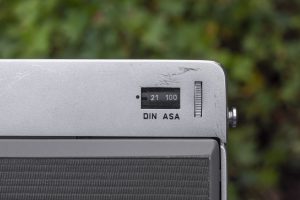
The ASA/DIN film speed control also doubles as aperture control with auto exposure disabled. On the Prakti II, aperture values are also displayed. White lightning bolt, black background – Shutter is at 1/30 for flash sync, focus is set to 2 meters offering variable depth of field using the same exact settings as Bulb mode explained above, auto exposure is disabled.
- Single person (Portrait), white background – Shutter is at 1/30, focus is set to 2 meters, f/stops chosen automatically, depth of field varies depending on available light.
- Three people (Groups), white background – Shutter is at 1/60, focus is set to 5 meters, f/stops and depth of field same as above.
- Mountains and house (Scenery), white background – Shutter is at 1/60, focus is set to 10 meters, f/stops and depth of field same as above.
- Galloping horse (Action), white background – Shutter is at 1/250, focus is set to 10 meters, f/stops and depth of field same as above.

The camera’s bottom is where you’ll find most of the other controls, such as the rewind knob, manually resetting subtractive exposure counter, rewind release button, 1/4″ tripod socket, and a little notch for opening the battery compartment. The exposure counter shows how many exposures are remaining and once the counter gets to ‘0’, the shutter release is deactivated. This is something worth checking if you get a Prakti and want to test it’s operation. Resetting the counter to any number than ‘0’ should reactivate the shutter.
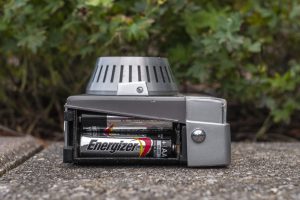
Powering the camera are two AA batteries on the camera’s side. This is interesting to me for two reasons, the first is that this was one of the first cameras to be powered by a AA battery. Although first introduced in 1907, the AA battery did not receive standardization until 1947 and was limited to small flashlights at this time. The use of AA batteries in cameras did not become common until the late 1970s, so it’s use in the Prakti was quite a revolutionary idea.
The second interesting thing is that the batteries can be changed with film loaded in the camera, which wasn’t always a given as cameras like the Canon Dial and Rollei 35 have their batteries within the film compartment which require you to open the film compartment to change.
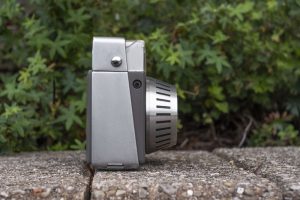
Opening the camera to load film requires sliding down on a release latch on the camera’s right side. When the latch is released, the entire door comes off. Also note the round strap post on the sides of the camera. To connect a strap to the Prakti requires a special connector that’s not common to modern day straps.
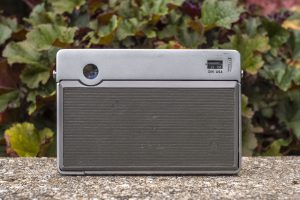
The camera’s back is mostly just a large swath of body covering, with the round opening for the viewfinder in the upper left corner, and the ASA/DIN film speed dial in the upper right. In both the camera’s Bulb and Flash modes, the film speed dial also doubles as the aperture control, as explained in the section above. On the later Prakti II, aperture f/stops were added to this wheel.
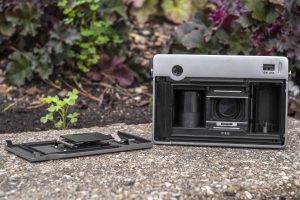
Removing the back of the camera reveals the film compartment. Film transport is from right to left onto a thick, non-removable take up drum which holds the film leader securely by a thick metal clip.
When loading film into the camera, it is critical to make sure the leader is securely attached to the take up spool as it will not be obvious that the film is transporting through the camera once the back is on. To ensure the leader is secure, with the back still off, press and hold the rewind release button on the bottom and manually turn the take up drum to make sure that the leader is securely attached and will not fall off. Then, after replacing the back, reset the exposure counter to 2 numbers higher than the number of exposures you’ve loaded, and fire the shutter twice to take up the blank exposures. If everything goes smoothly, you should see the rewind knob and handle rotate as the shutter is fired.
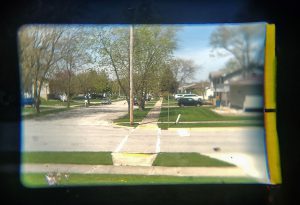
The Prakti’s viewfinder uses a porroprism rather than a simple straight through optical viewfinder. The advantage to this is a very bright and accurately framed image, but has the disadvantage of being difficult to see while wearing prescription glasses. If your eye is not perfectly centered in the exact right position, the edges of the viewfinder will blur or become completely invisible to the nature of how light travels through the prism. In the image to the right, you can see the entire frame, but notice how blurred the edges are. This is a result of it being difficult to get my camera’s lens in the exact position for an evenly sharp and in focus image.
On the right side of the viewfinder is a yellow strip that contains the meter’s read out. According to the manual, it is not necessary to get the needle perfectly in the middle like in the image to the right. The presence of the meter needle anywhere within the yellow means the camera can compensate for accurate exposure and only if the needle is outside of the yellow, means accurate exposure will not be obtained.
The Prakti was designed to be easy to use, and it’s lack of any other controls definitely make that point obvious. There are no settings to individually control shutter speed, aperture, or focus. There is no self-timer, film advance, or shutter cocking device. Even the viewfinder is as spartan as they come with only a framed image and exposure indicator. In good working condition, the camera only needs to be set to one of the six scenes you plan on using it in, and pressing the shutter release to make an exposure. It’s pretty clear the Prakti is easy to use, but what kinds of images does it make?
My Theo’s Results
I had been looking for a Prakti for quite some time before finding this example for sale by a collector in Minnesota. In my search for one, I had read about how almost all of them are dead as the electronic components do not stand up well to the rigors of time. People like Dr. Gejza Dunay (eBay seller ‘cupog’) who are brave enough to take apart most GDR cameras, won’t touch them.
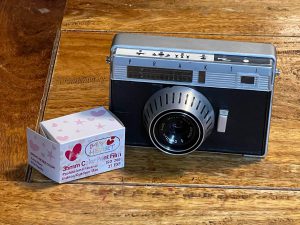
When I finally located one for this review, I knew the odds weren’t good that it would be working and of course when it arrived, it didn’t. At one point, I made a valiant effort to remove the top plate to see if I could see any obvious faults, and to my surprise, both wires going to the positive and negative terminals of the battery compartment had become desoldered, so thinking I found the problem, I got out my soldering iron and resoldered them, but sadly, the camera was still dead.
I thought the Prakti was interesting enough for a future Camera of the Dead review, but then one day my friend and fellow blogger, Theo Panagopoulos from photothinking.com said he had a working copy. Theo said he would be happy to loan me the camera, but his location in Sydney, Australia meant that a back and forth journey to me would be prohibitively expensive, so I asked if he would be willing to shoot a new roll of film in his for me to use in this review. Theo was happy to do so as he really likes his Prakti, so below are his shots on his Prakti using a film called “My Heart Print” which he says is just rebranded Fuji C200 film.
Before I comment on the camera, it is quite clear that I need to get to Australia as these images show a glimpse into an area of the world I’ve never seen up and close. Theo’s images are outstanding in both detail and composition. He is clearly a better photographer than I!
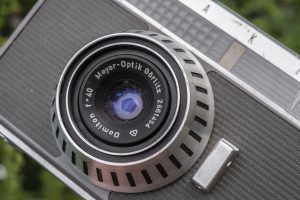
The Meyer-Optik Görlitz Domiton lens consistently delivered images with corner to corner sharpness characteristic of much more higher spec lenses. In an early draft of this review, I guessed the Domiton was a triplet but it is, in fact, a Tessar style 4-element lens.
Also evident from the consistently good images Theo got from his Prakti was how easily he was able to get them. The Prakti was designed to be easy to use and it is clear that the simple design worked well. I can imagine people buying these new in the 1960s were probably pretty happy with the images they got from theirs.
Since my only experience with the Prakti is a non-working one, I asked Theo to share some thoughts on it’s use.
The Prakti is a unique little camera which trailblazed motorized innovation in the 1960s. Being such an early camera with this functionality it has a few things to watch out for. Loading film can be tricky to ensure that it has caught on, as the way it is positioned it can slip through, as it did for me.
Shooting with it, it can be quite easy to forget to reset the distance/exposure settings as there is no indication in the viewfinder. I have lost quite a few frames with the Prakti due to this. The best setting to leave the camera on is the group shot or the landscape as this will give decent depth of field.
My favourite part of this camera is the results. They are of a decent quality (it would put some more modern cameras and lenses to shame) and they have a really old world feel to them. A very unique look!
In my research for this camera, the few times I found people who had a working camera, one limitation of the camera that often gets mentioned is the shutter speeds. Although boasting a shutter with a top speed of 1/250, this speed can only be used with the camera in Action mode, which sets the focus to 10 meters. Depth of field is affected by the meter, so as long as you have good light, you have the benefit of a smaller aperture.
In every other mode though, the shutter speed is limited to either 1/30 or 1/60 which will cause problems with faster films and motion blur with moving subjects. This means that ASA 100 films are about as fast of a film as you’d likely want to use in the camera, or else you risk over exposing everything in anything by Action mode.
The neatest part of using the Prakti is it’s motorized film transport, which as you might guess is pretty loud. Below is a short video Theo made of his camera’s shutter firing. While loud, it’s not entirely out of line from other motorized transport cameras of the era. That said, this is definitely not a camera you’d want to use if you were trying to be discreet!
Having handled a non working Prakti and now seeing (and hearing) Theo’s results from his, I do not know which I’m more sorry about, that my camera didn’t work, or that Theo’s did, because now after seeing what they are capable of, I want to keep looking! I would definitely love to get my hands on a working example, and if I am ever successful, I will definitely come back here and update this article.
With the dots I was able to connect from my non working and Theo’s working example, I feel as though the Prakti is worthy of being one of the most innovative cameras of all time. Here was a little known East German camera, produced by KW who was on the verge of being absorbed into Pentacon, creating a new camera that was unlike anything anyone had ever made before. They chose a power supply that wouldn’t be commonly used for almost two decades later, they simplified not only exposure, but focus in an era when auto exposure was still cutting edge and auto focus was a fantastical pipe dream out of an episode of the Jetsons, and although the camera has some strange ergonomics, it’s simplicity overshadows any sharp corners or left handed shutter release.
It’s a shame there weren’t more cameras like this, or that this model wasn’t produced by another company that could have done a better job of getting them out there, because I am certain if more people knew about them, they’d be much more in demand today. If the stars ever align and you find yourself in the position to pick up a working Prakti, I strongly recommend you do it…no wait, a minute, don’t buy it. Just let me know so I can!
Related Posts You Might Enjoy
External Links
https://zeissikonveb.de/start/kameras/prakti.html (in German)
https://www.photothinking.com/2019-06-14-prakti-early-prakticalities/
https://www.ddr-museum.de/en/blog/2019/ddr-design-prakti-camera
https://www.collection-appareils.fr/x/html/camera-9578-Pentacon_Prakti.html
https://www.kameramuseum.de/0-fotokameras/ddr/pentacon/kb-sucher/prakti.html

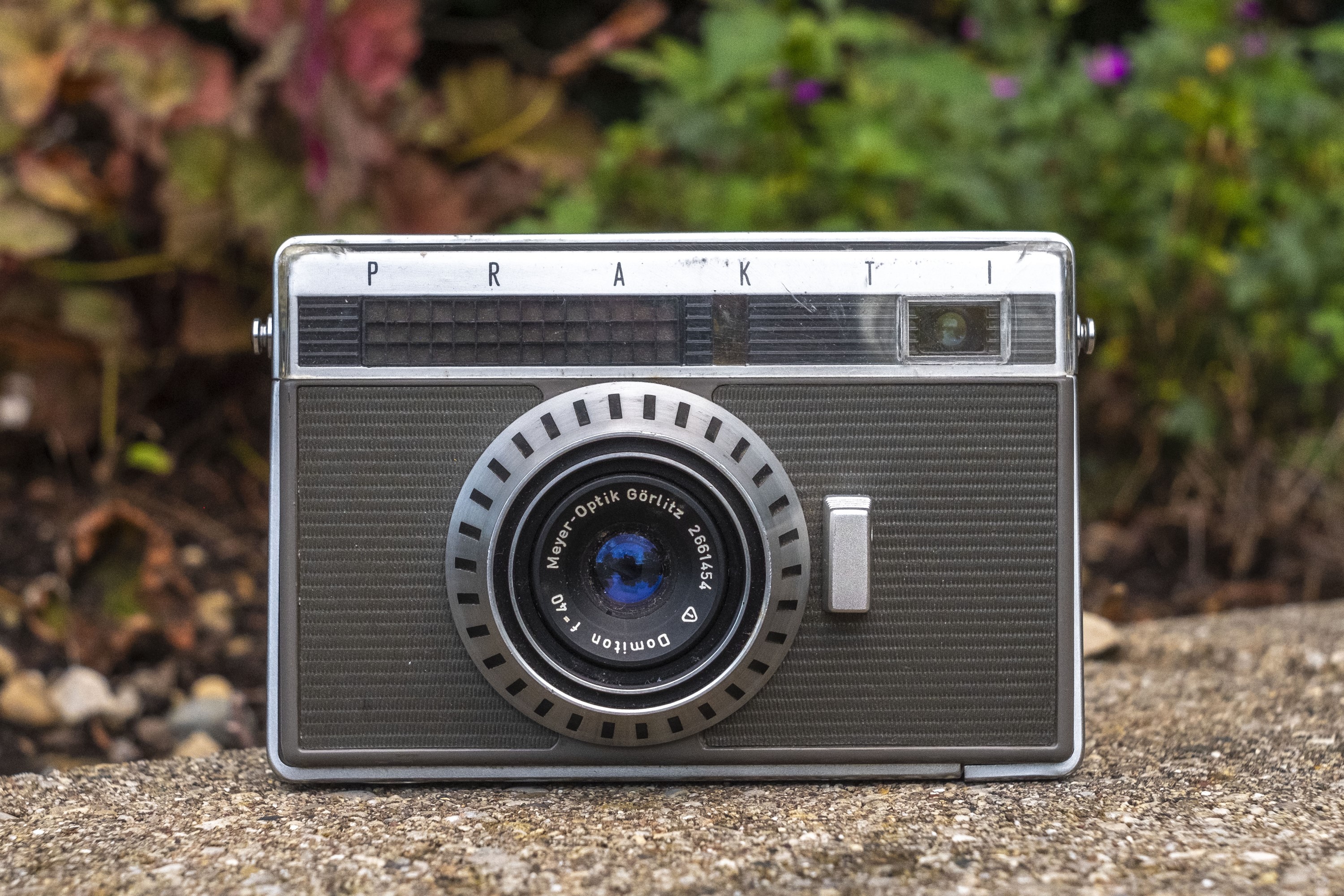
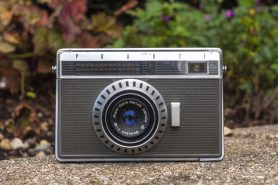
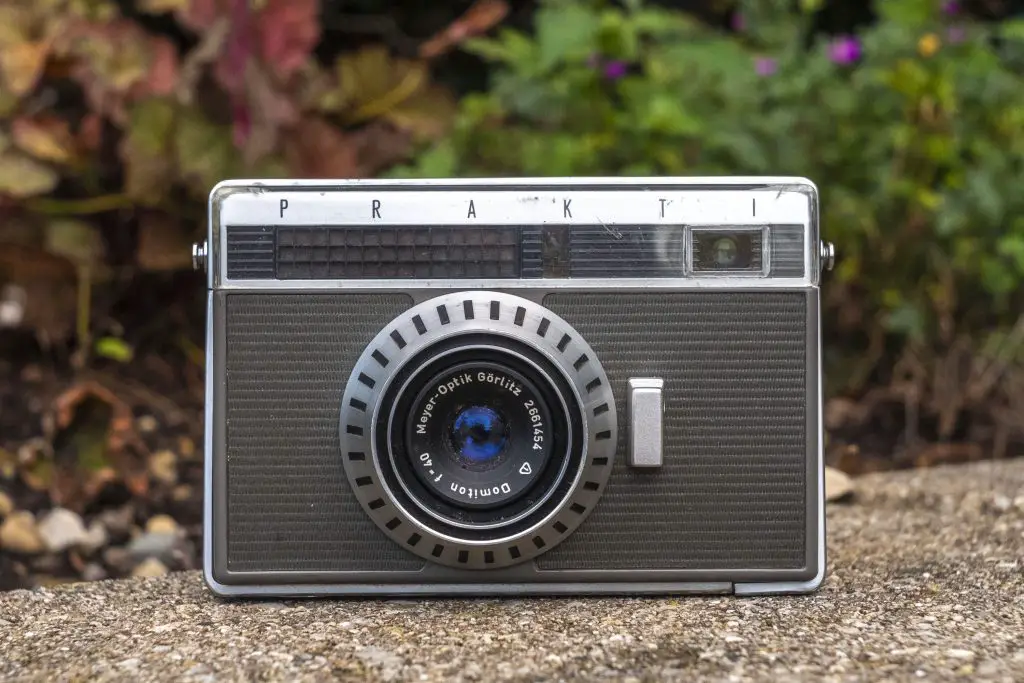
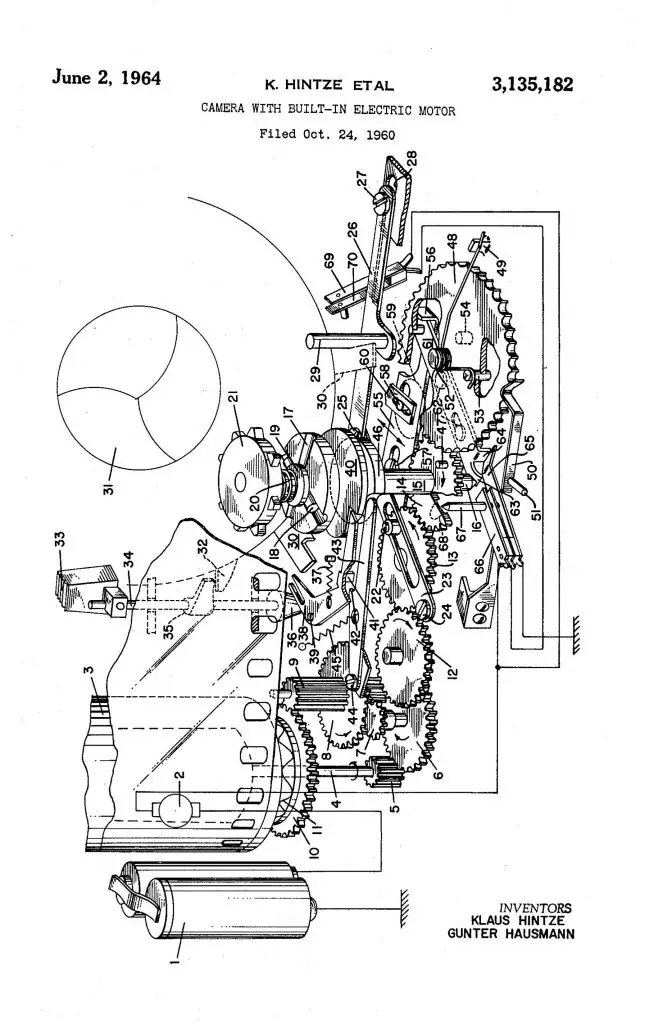
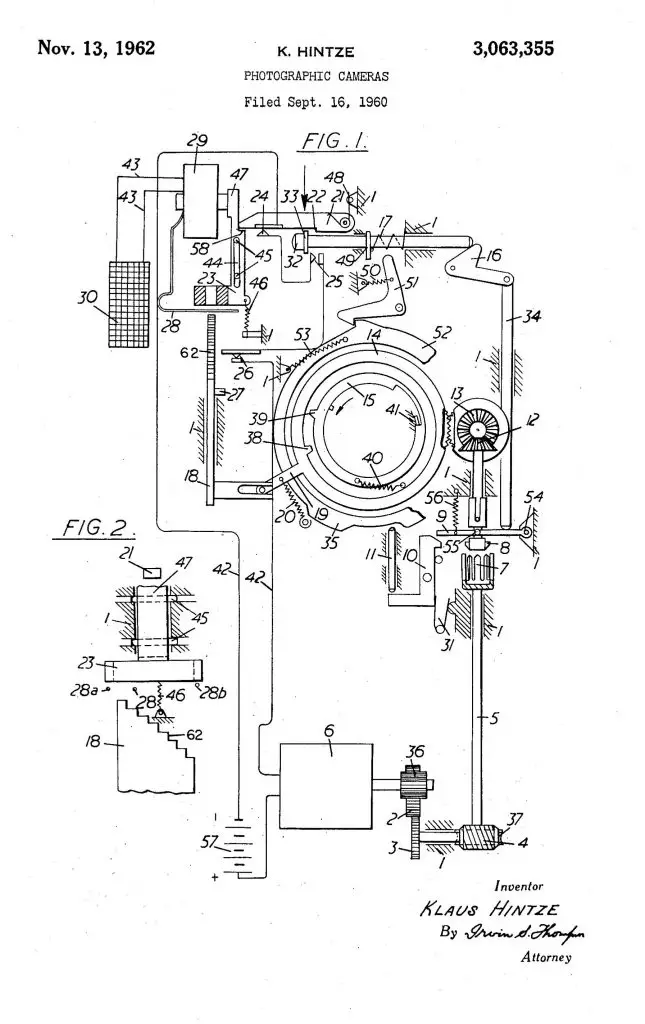
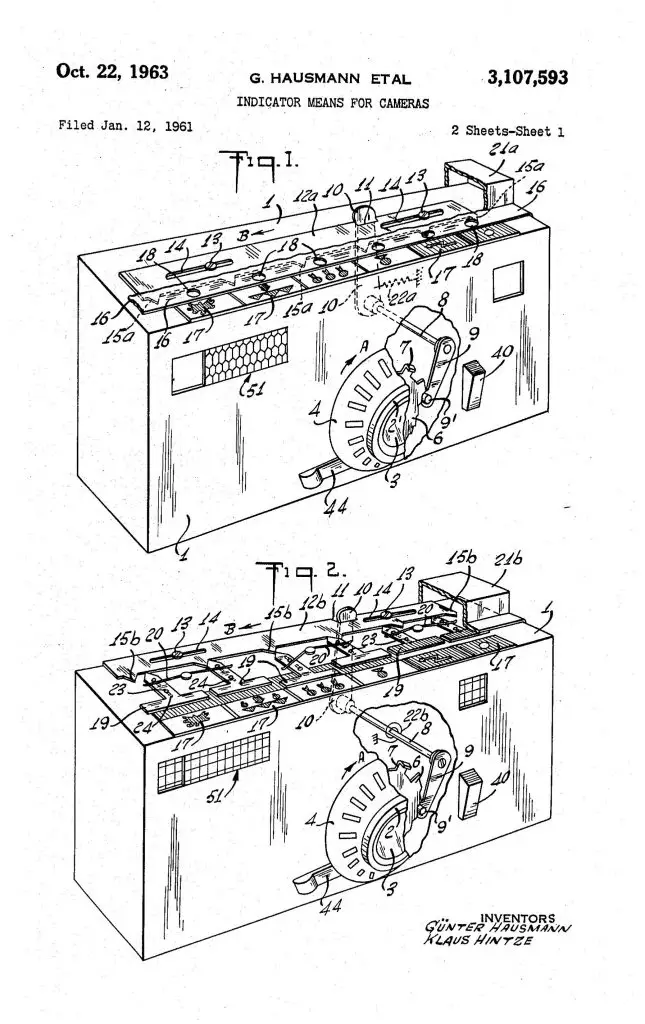


















Thanks!! Awesome article! I’ve been looking for one that work for a very long time. Without success
Yeah, that’s why when I found someone I knew with a working one, I just asked to use his images, as I felt as though I’d be looking forever to find a working one! The images do look really nice from that Domiton though…
Interesting camera. Cupog has had a working example for sale for some time now, on his ebay page.
I’ve actually seen that one for sale on cupog’s page. Read his description carefully as he says it definitely does not work. Like mine, the film transport has no power.
The film transport is normally easy to repair. More difficult is to open the fron where very important screws are.
I`m sitting since two weeks repairing one and it took me one week to find the single screw deep inside in the dark witch opens the front. Mostly open this screw destroys it. Don’t know why they didn’t use other and easier solutions.
But motor transport is mostly a contact problem or the motor is defective.
Hi Christian. I bought one defect Prakti. Problem is, that I cah hear motor moving, after I put the batteries. I have tried to open the camerab but I cannot see any screws. I have opened the upper part, but cannot find, how to open front. Have you made any photos of your repair? Can you help me somehow, plese. There is no service manual in net to find. Bet regards. Marek. Vienna.
“(…) which was right around the time KW was absorbed into VEB Pentacon.”
Mike, there’s something wrong about this part. KW couldn’t be absorbed by VEB Pentacon because KW was already a part of VEB Pentacon. KW merged with other East German camera makers to VEB Kamera- und Kinowerke Dresden in 1959. This corporate identity renamed itself to VEB Pentacon in 1964 for better brand recognition (http://camera-wiki.org/wiki/Pentacon). Probably you’ve mixed something up.
Michael, you’re right, I didn’t word that correctly. As you stated KW was already part of what would become VEB Pentacon Dresden. I have updated the wording to be more accurate.